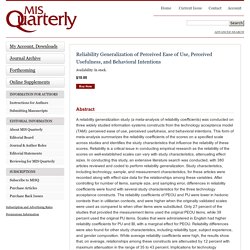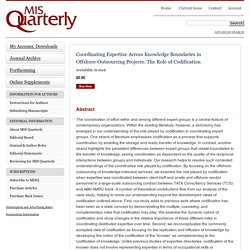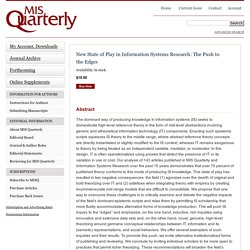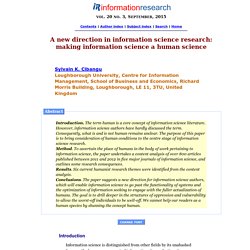

Document theory (IEKO) By Michael Buckland Table of contents: 1.

Introduction: 1.1. Knowledge organization and document theory; 1.2. Etymology; 1.3. Scope2. History3. [top of entry] 1. Document theory is a field that examines both the concept of a document and how it can serve with other concepts to understand better the complex areas of communication, documentation, information, and knowledge. 1.1. Emerald_S1876-0562(2013)0000008017.
Library & Information Science Syllabi. Mode 2-Konzeption : Transdisziplinarität. Mitte der 1990er Jahre wird in dem einflussreichen Buch The New Production of Knowledge darauf hingewiesen, wie sehr sich die Wissensproduktion in der zweiten Hälfte des 20.

Jahrhunderts durch technologische und gesellschaftliche Entwicklungen massgeblich verändert hat (Gibbons et al. 1994). Die AutorInnen beschreiben die traditionell akademische Wissensproduktion als Mode 1, die neu entstehende als Mode 2. Mode 1 wird als am newtonschen naturwissenschaftlichen Ideal orientierte Wissensproduktion beschrieben, die nur innerhalb eines akademisch-institutionellen Rahmens produziert werden könne. Die Mode 2-Wissensproduktion hingegen erfolgt in einem konkreten Anwendungskontext, sie ist transdisziplinär, heterogen und weder auf eine bestimmte Lokalität noch auf eine bestimmte akademische Form ausgerichtet.
Literatur. Library & Information Science - Google Scholar-Kennzahlen. MIS Quarterly. The rise of social broadcasting technologies has greatly facilitated open access to information worldwide, not only by powering decentralized information production and consumption, but also by expediting information diffusion through social interactions like content sharing.

Voluntary information sharing by users in the context of Twitter, the predominant social broadcasting site, is studied by modeling both the technology and user behavior. A detailed data set about the official content-sharing function on Twitter, called retweet, is collected and the statistical relationships between users’ social network characteristics and their retweeting acts are documented. A two-stage consumption-sharing model is then estimated using the conditional maximum likelihood estimatio (MLE) method. The empirical results convincingly support our hypothesis that weak ties (in the form of unidirectional links) are more likely to engage in the social exchange process of content sharing.
MIS Quarterly. A reliability generalization study (a meta-analysis of reliability coefficients) was conducted on three widely studied information systems constructs from the technology acceptance model (TAM): perceived ease of use, perceived usefulness, and behavioral intentions.

This form of meta-analysis summarizes the reliability coefficients of the scores on a specified scale across studies and identifies the study characteristics that influence the reliability of these scores. Reliability is a critical issue in conducting empirical research as the reliability of the scores on well-established scales can vary with study characteristics, attenuating effect sizes. In conducting this study, an extensive literature search was conducted, with 380 articles reviewed and coded to perform reliability generalization. Study characteristics, including technology, sample, and measurement characteristics, for these articles were recorded along with effect size data for the relationships among these variables.
MIS Quarterly. The coordination of effort within and among different expert groups is a central feature of contemporary organizations.

Within the existing literature, however, a dichotomy has emerged in our understanding of the role played by codification in coordinating expert groups. One strand of literature emphasizes codification as a process that supports coordination by enabling the storage and ready transfer of knowledge. In contrast, another strand highlights the persistent differences between expert groups that create boundaries to the transfer of knowledge, seeing coordination as dependent on the quality of the reciprocal interactions between groups and individuals.
Our research helps to resolve such contested understandings of the coordinative role played by codification. MIS Quarterly. The 50-year march of Moore’s Law has led to the creation of a relatively cheap and increasingly easy-to-use world-wide digital infrastructure of computers, mobile devices, broadband network connections, and advanced application platforms.

This digital infrastructure has, in turn, accelerated the emergence of new technologies that enable transformations in how we live and work, how companies organize, and the structure of entire industries. As a result, it has become important for all business students to have a strong grounding in IT and digital innovation in order to manage, lead, and transform organizations that are increasingly dependent on digital innovation. Yet, at many schools, students do not get such grounding because the required information systems core class is stuck in the past. We present a vision for a redesigned IS core class that adopts digital innovation as a fundamental and powerful concept (FPC).
MIS Quarterly. The dominant way of producing knowledge in information systems (IS) seeks to domesticate high-level reference theory in the form of mid-level abstractions involving generic and atheoretical information technology (IT) components.

Enacting such epistemic scripts squeezes IS theory to the middle range, where abstract reference theory concepts are directly instantiated or slightly modified to the IS context, whereas IT remains exogenous to theory by being treated as an independent variable, mediator, or moderator. The Concept of Information in Library and Information Science A F...: ingentaconnect. Information is not a difference. (And he would have been rather silly if he had.)

Aaron Sloman School of Computer Science, The University of Birmingham, UK This file is Also available as a PDF file (derived from HTML): Installed: 22 Jan 2011 Last updated: 24 Jan 2011; Reformatted May 2015; minor changes Apr 2016 Background What follows is based on section 2.3 of this book chapter: Aaron Sloman, What's information, for an organism or intelligent machine? These ideas are central to the Turing-inspired Meta-Morphogenesis project: CONTENTS Introduction: the Myth What Bateson Actually Wrote Introduction: the Myth It is widely believed that the polymath Gregory Bateson defined "information" as "a difference that makes a difference". A new direction in information science research: making information science a human science. Introduction Information science is distinguished from other fields by its unabashed focus on the human component of information, its production, its distribution and its use (Beam, 1983; Buckland, 2012; Kline, 2006; Saracevic, 1992, 1999; Wegner, 1983).

InfoWiss Potsdam sur Twitter : "Preisträger des #dhpreis15 zweiter Platz kommt aus der BSB #library Glückwunsch an Ceynowa und Griebel. #Library-Science" Information as self-organized complexity; a unifying viewpoint. Proceedings of the Sixth International Conference on Conceptions of Library and Information Science—"Featuring the Future" David Bawden City University, London, EC1V 0HB Introduction "The seemingly empty space around us is seething with information.

Much of it we cannot be aware of because our senses do not respond to it. Much of it we ignore because we have more interesting things to attend to. This short paper presents an approach to a theoretical framework for understanding information in the physical, biological and human domains.
Informationsgesellschaft.